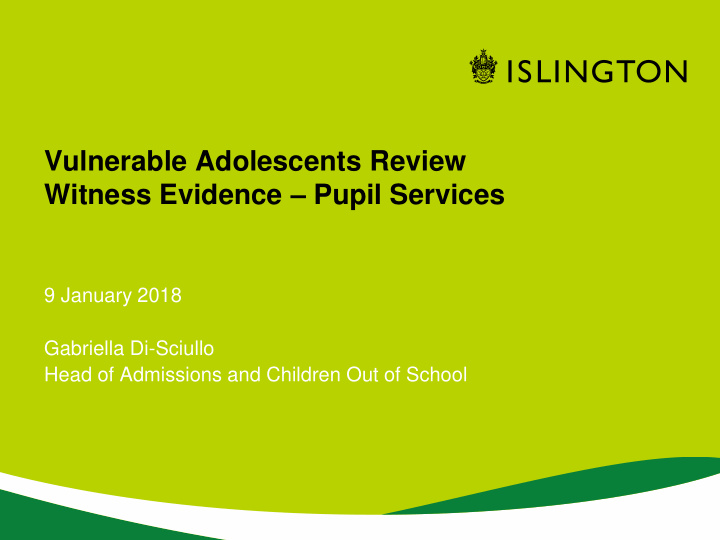



Vulnerable Adolescents Review Witness Evidence – Pupil Services 9 January 2018 Gabriella Di-Sciullo Head of Admissions and Children Out of School
Presentation Overview • Exclusion from school • School age offenders • ‘Hard to place’ pupils • Children missing from education • Persistent absence
Exclusion from school • Working together to prevent exclusion : – ‘Team around the School’ approach to support schools in managing challenging behaviour through bespoke training packages for whole school/targeted staff groups (e.g. Educational Psychology and CAMHS offers) – Range of targeted interventions to support individual children and specific groups (e.g. New River College and The Bridge Outreach services) – Designated CAMHS-Ed provision provided on site at all schools – Chance UK mentoring and Targeted Youth Support offer – Whole family approaches through ‘Early Help’ services (Families First and Islington Families Intensive Team) – Weapon-related protocol to ensure a consistent response and appropriate support to vulnerable pupils. • Outcomes: – Exclusions of children with an EHCP below national and inner-London figures – Reduction in the number of weapon-related permanent exclusions: 2012/13 2013/14 2014/15 2015/16 2016/17 10 6 9 11 9
School age offenders • Working together to support school age offenders : – monthly multi-agency education panel chaired by Pupil Services – ensure education provision is in place upon release from custody – track educational progress including attendance and examination entries – monitor plans for post-16 transition – s upport vulnerable young people with a ‘Youth Conditional Caution’ disposal – develop joint interventions to support and recognise achievement including: • Achiever of the Month – recognising child and parent support • Weekly Provider Update – to nip any issues in the bud and provide positive feedback quickly to the young person • Education Requirements (where appropriate) • Outcomes : – Significant reduction in the number of school age young offenders YOS School Age 2015/16 2016/17 2017/18 Average cohort size 28 27 11
‘Hard to place’ pupils • Working together to secure education provision: – Secondary Securing Education Board (SSEB) makes decisions about the admission of ‘hard to place’ pupils under Islington’s Fair Access Protocol arrangements – Independent Chair and multi- agency membership including head teachers, Children’s Social Care, Child and Adolescent Mental Health, Educational Psychology, Special Educational Needs, Youth Offending, and New River College (NRC) PRU – Considers requests for Preventative PRU placements, admission to NRC Medical, mainstream reintegration and alternative provision for vulnerable pupils new to the borough • Outcomes: – Appropriate allocation of education provision and support for ‘hard to place’ pupils, including ‘second chance’ mainstream placements. 2013/14 2014/15 2015/16 2016/17 4 Year Total Allocated provision # % # % # % # % # % Alternative 1 3% 0 0% 4 12% 6 16% 11 8% Provision Mainstream 11 33% 13 45% 6 18% 16 42% 46 34% Medical PRU 5 15% 6 21% 6 18% 7 18% 24 18% PRU 16 48% 10 34% 18 53% 9 24% 53 40% TOTAL 33 29 34 38 134 ALLOCATIONS
Children missing education • Working together to prevent children going missing from education: – All children of compulsory school age (between the ages of 5 and 16 years) must be in full-time education. A child is considered as missing from education if they are not on a school roll or being electively home educated. – Vulnerable groups include children: • housed in temporary accommodation • newly arrived to Islington • children leaving an Islington school, particularly those moving abroad • transferring to secondary school • failing to return to school after a period of absence or following the end of a school term. – Range of robust processes to identify, track and return children to education including annual ‘no - show’ process, ‘policing’ of off - rolling, monitoring of absence and ‘missing pupils’ through alert process. Housing notification process to track children moved to temporary accommodation. • Outcomes: • 100% of pupils off-rolled with a named destination. • 100% of secondary transfer pupils accounted for. • 87% of new arrivals to Islington starting at school within 20 school days (national standard). • Written confirmation from education provider for 81% of ‘Missing Pupils’ (mostly moving abroad); a further 14% confirmed as living abroad but unable to obtain written confirmation from new school; 3% unaccounted for and registered to national database (s2s) of ‘Lost Pupils’.
Persistent absence • Persistent absence has dropped significantly over a four-year period, despite the raising of the persistent absence threshold in Autumn 2015. This mirrors regional and national trends. • Latest whole-year figures for Islington indicate that secondary persistent absence continues to be significantly below the national average, and while remaining higher than those for our statistical neighbours and Inner London, the gap continues to narrow. Secondary persistent absence levels, 2012/13 to 2015/16 18% 16% 14% 12% 10% 8% 14.7% 6% 12.1% 12.2% 11.9% 4% 2% 0% 2012/13 2013/14 2014/15 2015/16 Islington 14.7% 11.9% 12.1% 12.2% Statistical Neighbours 13.7% 11.9% 12.3% 11.8% Inner London 13.5% 11.6% 12.0% 11.5% England 16.5% 13.6% 13.8% 13.1% Islington Statistical Neighbours Inner London England
Recommend
More recommend